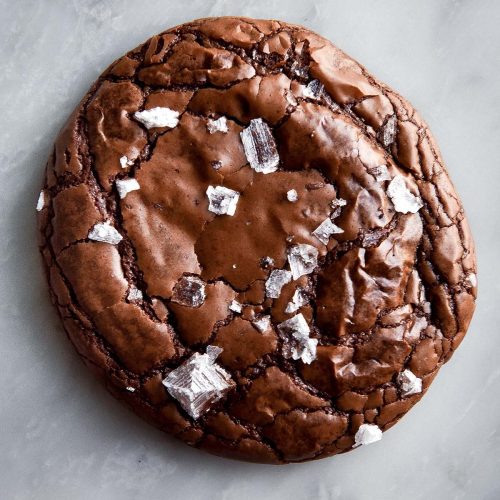
Gluten-free sourdough brownie cookies
Gluten free, nut free, FODMAP friendly*Cups and measures are Australian cups and measures. Use gram weights for international accuracy.
Ingredients
- 50 g butter
- 200 g dark chocolate (I used 70% sweetened cooking chocolate)
- 150g caster sugar
- 1 extra large egg (45-55g, weighed out of shell)
- 110 g sourdough starter discard or on a rise
- 20g (2 tablespoons)* cocoa powder both Dutch processed and regular are fine
- 20g (2 tablespoons)* (20g) tapioca flour
- 1/4 teaspoon baking powder
- 1/4-1/2 teaspoon fine salt, according to your taste for salt in desserts
- 1 teaspoon vanilla bean paste (optional)
- Sea salt flakes to finish
Instructions
- Preheat the oven to 180 degrees Celsius or 320 Fahrenheit.
- Brown the butter in a small saucepan until it reaches a deep golden colour and has a very nutty fragrance. It should weigh 40g or close to that number after browning.
- Half fill the small saucepan you used for the brown butter with water and place it on a medium heat. Pour the browned butter into a metal or heatproof bowl and place it on top of the saucepan, ensuring the water doesn’t touch the bottom of the bowl.
- Add the chocolate to the saucepan and stir intermittently until it is completely melted. Remove from the heat and set aside.
- While the chocolate is melting, add the caster sugar and egg to the bowl of the kitchen mixer. Using the whisk attachment, beat for 7-10 minutes on a medium-high speed until light and kind of fluffy. This helps create lift and a shiny meringue-like top.
- While this is happening, whisk together the cocoa, tapioca flour, baking powder and salt in a small bowl.
- Once the egg mixture is sufficiently lightened in colour, lower the speed of the mixer and pour in the sourdough starter. Once incorporated, add the melted chocolate. Use a spatula to get every last bit, and allow to continue processing on low until combined.
- Spoon in the flour mixture, letting each spoon mix in before adding more. Stop and scrape down the sides of the bowl with a spatula as necessary.
- Once the flour has been incorporated, turn the mixer off briefly to add the (optional) vanilla bean paste. If you don’t turn it off, the vanilla paste tends to get tangled in the whisk attachment. Continue mixing until combined.
- The batter should fall off the whisk attachment in relatively thick ribbons. It is thick, but still slightly thinner than a traditional cookie dough – you’ll need to use spoons to assemble.
TO BAKE:
- Very lightly grease or moisten two large baking trays and line them with baking paper. The grease will stop the paper slipping around while you're scooping the cookie batter onto the tray.
- Using two spoons, scoop roughly 1 1/2 tablespoons of batter per cookie onto a lined baking tray, leaving a little space for spread. Use less for smaller cookies. I like to spoon six medium – large cookies per sheet. Try to keep them in smooth-ish round blobs as this is how they'll look once baked.
- Sprinkle each cookie with a little sea salt and place both trays into the oven. Cook for 6-7 minutes or until the tops are crackly but the cookies are still soft. Swap the trays, and continue to cook for an additional 6 minutes. All up, the cookies should be in the oven around 13-20 minutes, depending on how done you like them. You can judge this by how done you like traditional brownies.
- Once cooked to your liking, remove from the oven and allow to cool and firm up on the baking tray. For best, chewiest results, allow the cookies to cool completely before eating. Sugar draws moisture from the air, so for best results store uneaten cookies in an airtight container in the fridge.
Tried this recipe?Let us know how it was!